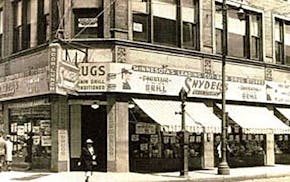Q: I was hearing cardinals starting to sing their springtime song in January. Why do they start so early, since they don't begin nesting until late spring?
A: It takes a lot of time and energy to secure and hold onto a good territory, and that's what the cardinals you're hearing are doing. Their "wha-cheer" sounds are announcing, over and over, that the area "fenced in" by their songs is already taken. You also may begin to see chases and even battles between male cardinals at this time of year, as one bird challenges another over a good habitat.
Awed by swans
Q: My husband and I were delighted by a flock of 60 to 70 trumpeter swans flying over our south metro home in late January. We assume they were flying to farm fields to feed. Are you aware of congregations of swans in the area?
A: It's amazing to consider that less than 100 years ago, there were fewer than 70 trumpeter swans left in Minnesota. After major reintroduction efforts by state and local naturalists and biologists, the population is greater than 50,000 swans in Minnesota. These awe-inspiring birds are the largest waterfowl species in the world. Look for them in winter at places with wide open water, such as the Mississippi River at Monticello, the National Wildlife Refuge in Bloomington and other sites. In nesting season, you might spy trumpeters just about anywhere, from big wildlife management areas such as Carlos Avery, to parks within the Three Rivers Park System, and even smaller parks like the Grass Lake Nature Preserve in Shoreview. A key factor in funding restoration efforts has been donations made by citizens on their state tax forms, known by many as the "chickadee checkoff."
A home for goldies
Q: I want to put up some birdhouses this summer and I love goldfinches, especially. Can you tell me what kind of birdhouse they prefer?
A: Sorry to say that goldfinches won't nest in any kind of nest box you set out. They, like most nesting birds in our state, prefer to nest "in the open," building their nests themselves tucked back in a shrub or tree branches. But there are many desirable birds you might attract to your nest boxes from the list of cavity nesters — birds that evolved to nest in tree holes and readily accept human-made structures. These include chickadees, wrens, nuthatches, bluebirds, tree swallows, woodpeckers and, in larger boxes, owls and some ducks.
Canary yellow
Q: I love how goldfinches start looking bright yellow again at this time of year, but why do they change color in the fall? What purpose does it serve?
A: In the spring, in the songbird world, it's all about catching the eye of female birds for mating purposes, and bright plumage indicates a bird's health and suitability as a breeding partner.
But if we notice canary-like goldfinches, so do predators, like hawks and cats. Once these little finches have wrapped up the breeding season, goldfinches molt into a duller coat for winter, to blend in better with leafless trees and shrubs to try to escape predators' notice.
Pest control
Q: Once the ground thaws, starlings start making holes all over my lawn. Why do they do this?
A: European starlings scuttle over our lawns and fields, stabbing their beaks into the ground in search of insect larvae. The holes they leave could be considered a small price to pay for their insect control services, so the grubs and other larvae they consume won't grow up to be harmful adult insects. For example, Japanese beetle and cutworm moth larvae, both highly destructive pests as adults, are a big treat for starlings.
Hosting hummingbirds
Q: When do you advise putting out my hummingbird feeder?
A: Hummingbirds begin arriving back in our area the last week in April, so I put out the nectar feeders around that time. If nighttime temperatures drop below freezing, it's a good idea to bring in feeders at dusk and re-hang them at sunrise.
Bad seed?
Q: The finches just won't eat my thistle seed. I cleaned out the feeder and put in new seed, but still no action. I relocated the feeder, but they still won't go for it. They do eat safflower and sunflower seeds, so what is going on?
A: There's something about your nyger seed (aka, thistle seed) that your finches don't like. Nyger seed is very oily and can go rancid quickly, even if it's newly purchased — it might have been sitting in a plastic bag for a long time. I've read that the best way to keep this seed fresh is to freeze it, either in your home freezer or outside in winter, in a sturdy metal trash can with a lid (to thwart squirrels). You'll need to take steps to keep the seed fresh in summer, too, because the heat can make the seed unpalatable. Since your finches won't touch the seed, it's best to toss it in the trash and start over. Start with a small quantity, maybe 5 pounds, purchased at a wild bird store, where the seed is always fresh. You might try a mixture of nyger and small pieces of sunflower seed; finches relish this at my feeders, and it cuts the cost a bit.
Fewer feeder birds
Q: I swear there were fewer birds at my feeders this winter. I'm worried that this was caused by bird flu killing off the birds.
A: The experts say that avian influenza is almost entirely a disease of poultry and waterfowl (with raptors quite vulnerable, as well). For example, Chicago had a major die-off in January of red-breasted mergansers, with dead or dying ducks piling up on beaches, parking lots and sidewalks along Lake Michigan, after becoming infected with the avian flu. In terms of feeder birds, if you're seeing less traffic at your feeders, it's almost certainly due to other causes. Something has changed in your neighborhood or birds are spending more time at a neighbor's feeders. Another factor might be that at the time you sent your query, there still was a good crop of wild fruit and seeds out in the wild, so birds might have been filling up on these.
Note to readers: Phyllis Bernard of Little Falls, Minn., enjoyed watching some unusual bird behavior recently in a bush outside her kitchen window: "After a slight thaw, icicles were dripping from the eaves onto a bush that birds rest in after feeding. I observed a pair of cardinals 'showering,' scampering from branch to branch to get a decent shower, then they'd fluff up their feathers. It was such a delight to watch."
St. Paul resident Val Cunningham, who volunteers with bird organizations and writes about nature for local, regional and national newspapers and magazines, can be reached at valwrites@comcast.net.

When West Seventh Pharmacy closes, St. Paul will lose a piece of history and personal care

John Cusack dishes on 'High Fidelity' at Minneapolis screening

For 'Legally Blonde' star, 'being underestimated is her secret superpower'

Restaurant openings and closings in the Twin Cities

